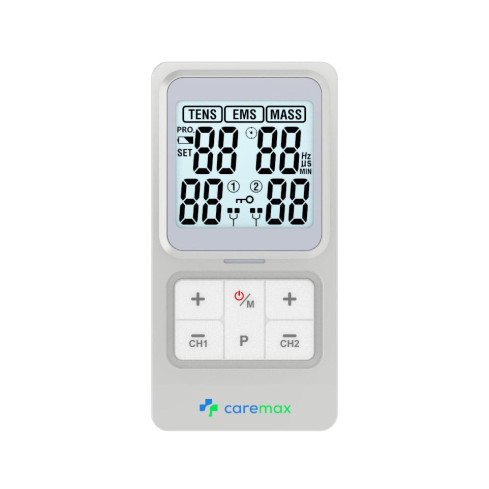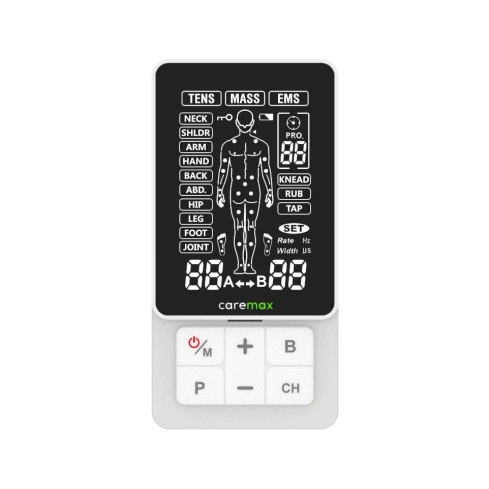Product added to cart
- Home
- TENS & EMS
- Use the TENS Machine for Neck and Shoulder Pain Relief: A Complete Guide
Use the TENS Machine for Neck and Shoulder Pain Relief: A Complete Guide
Neck and shoulder pain is a global issue that affects everybody, ranging from athletes to office workers. Using a TENS (transcutaneous electrical nerve stimulation) machine to ease neck and shoulder pain has become a popular and effective treatment approach. This portable and user-friendly device can help with immediate and long-term pain relief. Read this guide to see how you can use a TENS machine for your neck and shoulder pain today.
What is neck and shoulder pain?
Neck and shoulder pain is a common discomfort that can result from various factors, including muscle strain, poor posture, injury, or underlying medical conditions. It typically describes pain that begins around the back of the neck and extends to the upper back and shoulders. Especially in the modern world, neck and shoulder pain is particularly common among office workers due to the time spent in front of a monitor and poor posture.
What causes neck and shoulder pain?
There are many potential causes of neck and shoulder pain, including:
- Prolonged periods of time spent sitting in front of a screen
- Neck spasm
- Whiplash
- A wry neck
- Underlying conditions (e.g., arthritis, disc herniation, etc.)
- Injury, such as a sprain or strain
- Poor posture
- Inflammation
- Inactivity
- Arthritis
Range of Neck and Shoulder Pain Symptoms
The most common symptom of neck and shoulder pain is discomfort and soreness around these areas. Other symptoms may also include:
- Reduced mobility and stiffness
- Weakness
- Restricted movement
- Limited capacity to exercise and move
- Pain extending into the arms and upper back
- Headaches
- Migraines
- Brain fog
Traditional Treatment Methods for Neck and Shoulder Pain
There are many traditional treatments for neck and shoulder pain that vary in success. These include:
- Massage
- Corrective exercises and stretching
- Ergonomic corrections in the office
- Heat therapy
- Physiotherapy
- Osteopathy
- Myotherapy
- Cupping
- Acupuncture and dry needling
What are the stages of neck and shoulder recovery?
Stages of neck and shoulder pain recovery will vary between conditions and individuals. For more chronic conditions, such as arthritis, the focus of treatment will be preventing and managing symptoms. However, stages of recovery for general neck and shoulder pain include [1]:
- Preventing activities that aggravate pain and finding ways of relieving pain (e.g., heat packs, massages, etc.)
- Slowly restoring neck and shoulder movement.
- Recovery from residual symptoms
- Resuming a normal lifestyle
What is a TENS machine, and how can it help with neck and shoulder pain relief?
A TENS machine is a small device that is used for immediate and long-term pain relief. It delivers electric current through the skin via attached gel pads. This electrical current is set to target sensory nerves, which help protect against the pain signals that travel to the brain [2]. Applications on the neck and shoulder can help reduce the transmission of nociceptive (or pain) signals from these areas.
What's the best way to use a TENS machine for neck and shoulder pain relief?
The best way to use the TENS machine will depend on several factors, including the cause of pain, how long you’ve had symptoms, and your personal preference. There will be several settings that you can adjust to achieve the desired result. Please read further to see how you can optimally use your TENS machine.
Here are the best practices for using a TENS unit:
Position of electrode pads for neck and shoulder pain
The optimal positioning of the electrode pads may vary from person to person and between symptoms. The image below highlights our recommended placement of these pads, which are located at the base of the neck and around the upper trapezius.
Setting the TENS Mode for Neck and Shoulder Pain
Depending on your Caremax TENS device, there may be several settings that you can use, including massage and TENS. The TENS mode has specifically been programmed to assist with pain relief. On the other hand, the massage setting helps with muscle relaxation and comfort. However, user preference is equally important.
Setting the Pulse Rate (Frequency) for Neck and Shoulder Pain
Your selected frequency will depend on the type of pain relief that you’re seeking [3].
Higher frequencies, between 90 and 130 Hz, are used for rapid and immediate pain relief. On the other hand, lower frequencies between 2 and 5 Hz help with gradual and longer-lasting pain relief.
Setting the Pulse Width for Neck and Shoulder Pain
Currently, more research is required regarding the optimal pulse width for neck and shoulder pain. Most scientists recommend a pulse width between 50 μs and 250 μs [4]. Selecting your optimal frequency, mode, and intensity is more likely to lead to your desired outcomes [3].
How Often Should You Use Your TENS Machine for Neck and Shoulder Pain?
For neck and shoulder pain treatment, researchers have recommended using the TENS machine for 15–30 minute sessions as often as daily use [5]. It’s important to speak to your healthcare professional or doctor about appropriate use.
Using Caremax TENS machine for Neck & Shoulder Pain Relief
We provide a comprehensive packaging solution for Shouder & Neck Pain Relief. Discover the most sought-after products below essential for effective TENS therapy treatment.
 |
 |
| Caremax 2.0 Classic TENS machine | Caremax 2.0 Pro TENS Machine |
Other Home Exercises to Relieve Neck and Shoulder Pain
For the most appropriate exercises to relieve neck and shoulder pain, we recommend speaking to your physiotherapist.
Some exercises that may assist with neck and shoulder pain include:
Where and when to not use TENS machines
While the TENS machine is generally deemed safe, it's crucial to exercise caution in specific situations and areas. Refrain from using the TENS machine on compromised skin (like wounds or cuts), areas with altered sensation (such as tingling or reduced sensitivity), swollen regions, near cancerous or clot-prone areas, locations subjected to radiotherapy or radiation, and around critical arteries in the neck, especially the carotid area. When contemplating the placement of electrodes around the face or head, it is advisable to consult a qualified health professional for guidance [6].
Moreover, certain individuals, including pregnant women, those with implanted devices (such as pacemakers or neurostimulators), individuals facing cognitive or mental challenges, and those unable to provide consent for treatment, should either avoid using the TENS unit or seek advice from their GP before doing so [6].
Are there any risks of side effects when using a TENS machine?
Transcutaneous Electrical Nerve Stimulation (TENS) is a widely employed method for managing pain by delivering low-voltage electrical currents through electrodes to alleviate discomfort. Despite its general safety, it is vital to be mindful of potential side effects. This overview delineates both common and more severe side effects linked to TENS use, underscoring the significance of proper application and prompt medical attention in the event of adverse reactions. If any side effects are observed, discontinuing the treatment is essential. The reported side effects include [6]:
Commonly reported side effects:
- Skin irritation
- Unusual sensations around the treatment area
- Less common side effects:
It occurs when the TENS unit is used inappropriately or in unsafe areas.
Unsuitable candidates may experience more severe side effects.
- Rashes
- Increased pain
- Seizures
- Disruptions to implanted medical devices
- Strokes
- Blood clots
- Skin damage
- Burns
References
- Lewis, J. S., & Sandison, A. (2020). Transcutaneous Electrical Nerve Stimulation (TENS) in musculoskeletal pain: Impacts of session parameters on outcomes and patient satisfaction. British Journal of Sports Medicine, 54(2), 72.
- Johnson, M. I., & Ashton, C. H. (2011). Transcutaneous Electrical Nerve Stimulation (TENS) for cancer pain in adults. Cochrane Database of Systematic Reviews, (11), CD011927.
- Watson, T. (2017.). Transcutaneous Electrical Nerve Stimulation. World Wide Wounds. Archived from https://web.archive.org/web/20170809062344id_/https://www.wwmsi.com/documents/WWMSI_Transcutaneous_Electrical_Nerve_Stimulation_Tim_Watson.pdf
- Johnson, M. I., & Ashton, C. H. (2011). Transcutaneous Electrical Nerve Stimulation (TENS) for cancer pain in adults. Cochrane Database of Systematic Reviews, (11), CD011927.
- Filardo, G., Maestroni, L., Merli, G., Brogini, S., Pulsatelli, L., & Spoliti, M. (2021). Transcutaneous Electrical Nerve Stimulation in the management of knee osteoarthritis: A systematic review and meta-analysis of randomized controlled trials. Applied Sciences, 11(8), 3423.
- Boardman, L. A., & Long, J. A. (2018). Contraindications and precautions for the use of transcutaneous electrical nerve stimulation (TENS) in pain management. University of Iowa Hospitals and Clinics. Retrieved from https://www.healthcare.uiowa.edu/marcom/uihc/pain_medicine/contraindication_precautions_best062018.pdf
Categories
- TENS & EMS (19)
- Latest News (41)
- Massager (2)
- Nebuliser (8)
- Skin Care (3)
- Period Pain Management (1)
- Fitness (2)
